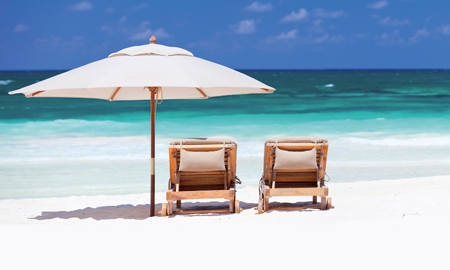Mexico has long enjoyed its status as one of the world’s the most visited countries, which comes as no surprise considering its year-round sunshine and warm, temperate climate that is complimented by two vast stretches of coastline generously scattered with bountiful and beautiful beaches.
Add to that a unique blend of culture, characterised by a colourful fusion of Mesoamerican and European ethnicity – and embodied by such major tourist draws as its Mayan ruins, colonial cities and indigenous tradition – and it is easy to understand why Mexico is a massively popular destination.
You might even say that the country is blessed with natural gifts and attributes. And it perhaps benefits from none more so than a geographically strategic location next to one of the world’s largest and most affluent consumer markets – the USA.
Indeed, for all its touristic success, over the years Mexico has heavily relied on its neighbours for the vast majority of foreign visitors. Being just a short flight or even a short drive across the border, Mexico has remained the traditional number one beach getaway for many Americans.
However, Mexico has now come to realise that you cannot put all your eggs in one basket, especially following the financial crises that rocked American homes and subsequently led to a big fall in the number of “vacationers” at the end of last decade.
“The USA is our number one market, however in recent years we have diversified to other international markets, lowering our dependence on North America and having a portfolio of much healthier markets for the country,” explains Rodolfo Lopez Negrete, the General Manager of CPTM (Mexico’s Tourism Promotion Council).
As the nation’s fifth-biggest source of revenue, tourism accounts for over 9 per cent of GDP and employs around 7 million people, so it is no wonder the government has become concerned with the long-term “health” of the sector.
When former President Calderon came into office in 2006, Mexico was receiving some 162 million national and international tourists. Fast forward to 2012 and there were a record-breaking year 191 million visitors recorded (24 million hailing from abroad), with more visitors from outside North America than ever before.
Simply, the reason why Mexico has experienced such growth is largely due to the fact that the Calderon administration invested 300 per cent more in the tourism sector than the previous government did, employing a much greater focus on the promotion and diversification of the sector.
This mantle has been firmly taken on by President Peña Nieto. “Without a doubt the Peña Nieto administration has been very clear and very specific in recognising that the tourism sector in the country is one of the most important strategic sectors; it is an engine of economic development, job creation and economic benefits for the country,” affirms the CPTM chief.
And while tourism clearly remains a key industry for Mexico, within the sector, the United Kingdom is becoming a gradually more vital market. Given the drastic fall in the cross-border flow from the US, Mexico has been making a concerted effort in attracting more visitors from countries such as Britain, Spain, Russia and Brazil.
The British tourist in particular is seen as a key component not just in Mexico’s diversification of its tourist pool, but also in the successful diversification of its tourism services away from the ‘sun-and-sand’ type packages.
Recent socio-economic analyses has shown that the average British visitor looks to gain more from their time and money than from your average seaside break, especially considering the 5,000-mile, 10-hour journey by plane.
“The English market is an explorer and an adventurer market and I think that the degree of satisfaction that it provides to the English market is incredibly attractive,” adds Mr Lopez Negrete.
“Sun and beaches can be found in Mexico, but also culture, gastronomy, handicrafts, music, archaeology, colonial destinations, history, folklore and everything attached with the innate characteristic of the Mexican which is hospitality.”
This encapsulated, Mexico is now considering the attraction of UK tourism as the perfect platform for promoting the nation’s more cultural side. Indeed little known to most, Mexico has the largest number of UNESCO designated World Heritage Sights of any country in the Americas and the sixth most in the world, with 27 cultural sites and five natural sites in its outstanding repertoire.
With the UK having been actively targeted as a strategic market by the government, the two sides also struck up a significant partnership last year when the Mexican Ministry of Tourism and Britain’s national tour agency, VisitBritain, signed a Memorandum of Understanding (MOU) towards increasing the flow of tourism between the countries.
While the increased promotion and rapidly rising profile of Mexico has already contributed to an increase in UK visitors (350,000 arrived in 2011, 3.3 per cent more than 2010), the MOU agreement will focus on further developing tourism initiatives in nature, sports and, importantly, “luxury” tourism (there has been a sharp influx of high-end hotel and golf resorts popping up recently, with the country voted world’s second most luxurious destination in 2013 by the travel network Virtuoso).
Going forward, the Mexican government is now looking not only to continue to diversify its tourism industry, increasing the number and range of tourism that it attracts, but also to invite greater foreign investment in tourism infrastructure.
Hector Martin Gomez Barraza, General Director of Fonatur, (the state agency that plans and develops infrastructure for Mexico’s tourism projects and is largely behind the incredible success of the country’s Cancún resort), says that similar to the British tourist, the British investor is also essential for Mexico.
“Undoubtedly, the UK represents a market with economic potential that we must capitalise on. This, as well as the approaches we could achieve with UK investors will help us achieve our goal to make tourism a true leverage of national development.”
0 COMMENTS